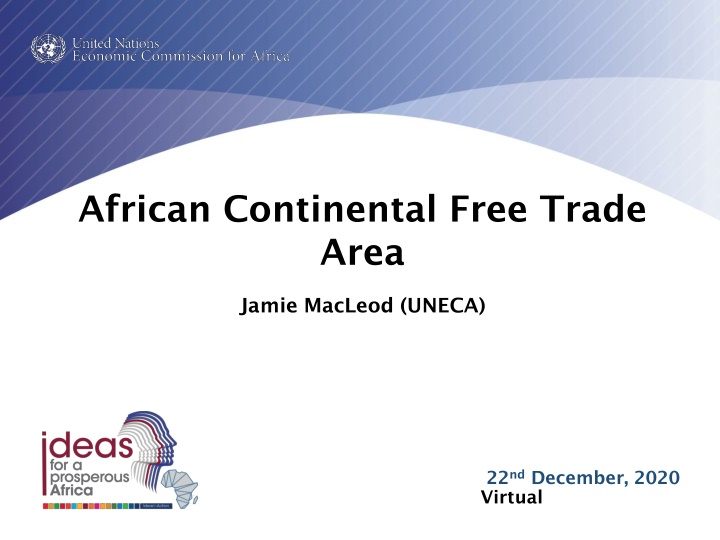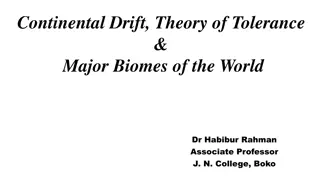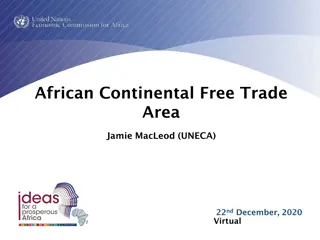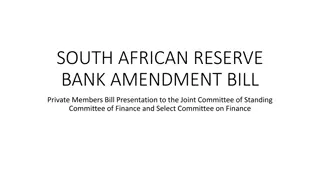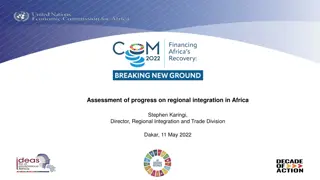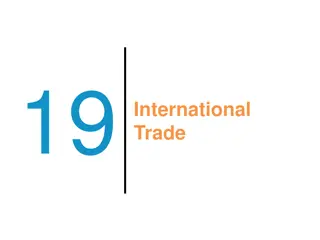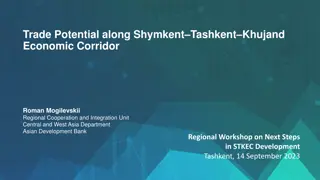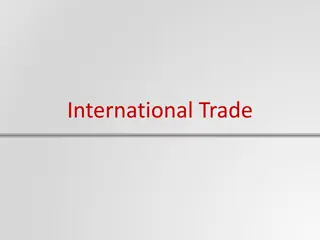Advancing the African Continental Free Trade Area: Opportunities and Challenges
The African Continental Free Trade Area aims to consolidate a fragmented market, capitalize on Africa's market growth, and diversify Africa's exports. With the potential to create a $2.3 trillion market of 1.3 billion people, the AfCFTA is poised to improve competition, lower business costs, and foster economic growth. Challenges include varying regulatory standards and trade barriers across African countries, hindering seamless business operations.
Download Presentation

Please find below an Image/Link to download the presentation.
The content on the website is provided AS IS for your information and personal use only. It may not be sold, licensed, or shared on other websites without obtaining consent from the author.If you encounter any issues during the download, it is possible that the publisher has removed the file from their server.
You are allowed to download the files provided on this website for personal or commercial use, subject to the condition that they are used lawfully. All files are the property of their respective owners.
The content on the website is provided AS IS for your information and personal use only. It may not be sold, licensed, or shared on other websites without obtaining consent from the author.
E N D
Presentation Transcript
African Continental Free Trade Area Jamie MacLeod (UNECA) 22nd December, 2020 Virtual
Consolidating a fragmented market African countries by population: 2020 estimates Africa is a big market, fragmented into small pieces Seychelles Sao Tome & Principe Cabo Verde Comoros Djibouti Eswatini 22 African countries have populations under 10m Mauritius Equatorial Guinea Guinea-Bissau Lesotho Populations < 10m Gabon Botswana Gambia Trade is frustrated by 107 unique land borders between 54 states Namibia Eritrea Mauritania Central African Republic Liberia Congo Rules diverge across: regulatory standards, competition, investment intellectual property rights, services making the scaling of business across borders difficult Libya Sierra Leone Togo South Sudan Burundi Tunisia Benin Rwanda Guinea Zimbabwe Somalia Chad Senegal Populations < 30m Zambia Malawi Mali Burkina Faso Niger AfCFTA consolidates Africa into $2.3 trillion market of 1.3bn people C te d'Ivoire Cameroon Madagascar Mozambique Ghana Angola Morocco Sudan Algeria Creates: market opportunities, scale economies, improved competition, lower business costs Uganda Kenya Tanzania South Africa DR Congo Egypt Ethiopia Nigeria 0m 50m 100m 150m 200m 250m
Taking advantage of Africas market growth African market population projections 3.0 bn 2.5 bn 2.0 bn 1.5 bn 1.0 bn 0.5 bn 0.0 bn 2000 2010 2020 2030 2040 2050 2060 of which middle class Population Source: AfDB (African Development Bank). 2011. Africa in 50 years time: the road towards inclusive growth, African Development Bank Group, Tunisia 6 of top-10 fastest growing economies were African in 2019 (7 of 10 in 2020 forecasts) Population expanding from 1.3bn in 2020 to 2.75bn by 2060 GDP forecast to grow from $3tr in 2020 to $16tr by 2060
Diversifying Africas exports Exports within Africa Exports to outside Africa Extractive 40% Extractive 70% Source: ECA 2019 Few countries have developed without industrialising Yet in 2019, Africa struggles with industrialization, instead remaining economically oriented around raw material extraction Intra-African trade helps: 70% of exports outside the continent are extractives, while less than 40% within are extractives
Case study: undiversified exports in 2020 with Covid-19 Composition of Africa s total exports Prices of Africa s most important commodities 130 Gold price 120 Metals Index Petroleum oils 40% 110 FAO Food price index 100 Cotton 90 Metals and ores 12% 80 70 Foodstuffs 11% 60 Brent crude Gold 7% Textiles 4% 50 40 Other 27% 30 Source: Based on ITC TradeMap Data (2016-18 average) and FAO and Trading Economics, November 2020 As the severity of COVID-19 emerged through Feb-Mar, commodity prices plummeted for more than 67% of Africa s exports with a modest improvement from April Brent crude down 70%, Cotton (proxy for textiles) down 25%, metals down 20%, average food prices down 10% - at nadir
Addressing longstanding trade facilitation challenges African Costs of Transportation are 63% higher than developed countries Freight Costs as % of Import Value are 11.4% for Africa vs. 6.8% for developed countries Customs Transactions include 20-30 different parties, 40 documents, 200 data elements Customs Processing Delays can cost $185 per consignment for each day of delay
Cohering African trade policy Source: AfDB (African Development Bank). 2011. Africa in 50 years time: the road towards inclusive growth, African Development Bank Group, Tunisia Consolidating Africa position against: Mega-regional trade agreements, protectionism, new trade issues, post-AGOA negotiations
Architecture of agreement Annex 1: Schedules of Tariff Concessions Annex 2: Rules of Orgin Annex 3: Customs Cooperation and Mutual Administrative Assistance Annex 4: Trade Facilitation Annex 5: Non-Tariff Barriers Annex 6: technical Barriers to Trade Annex 7: Sanitary and Phytosanitary Measures Annex 8: Transit Annex 9: Trade Remedies Protocol on Trade in Goods Framework Agreement Establishing the African Continental Free Trade Area Schedules of Specific Commitments MFN Exemption Annex on Air Transport Annex 1: Working Procedures of the Panel Annex 2: Expert Review Groups Annex 3: Code of conduct for Arbitrators and Panelists Protocol on Trade in Services Protocol on Dispute Settlement To be concluded Protocol on Intellectual Property Rights To be concluded To be concluded Protocol on Competition Policy Protocol on Investment
In concrete terms From January 2021, tariffs on 90% of goods traded between AfCFTA State Parties are to be reduced in equal annual installments until they are eliminated within 5 years for non-LDCs and 10 years for LDCs. So, a product facing a tariff of 25% being imported into a non-LDC would be tariffed at 20% from Jan 2021, then 15% from Jan 2022, with such reductions each year until it is traded duty-free by Jan 2026. For an additional 7% of sensitive goods, tariffs will fall within 10 years for non-LDCs and 13 years for LDCs. A final 3% of excluded products are to retain their tariffs to allow flexibilities for State Parties with particular sensitivities, but will be subject to a review every five years. Businesses also already have recourse to the NTB Mechanism, available at https://tradebarriers.africa/home. The AfCFTA also contains commitments on customs cooperation and mutual administrative assistance, trade facilitation, technical barriers to trade, sanitary and phytosanitary standards, and trade transit. These work behind the scenes to simplify and harmonize trade procedures and logistics, expedite the process of importation, exportation and transit, and to harmonize and mutually recognize standards, and eliminate unnecessary barriers to trade.
In concrete terms: services State Parties will submit schedules of commitment for the liberalisation of trade in services in the five priority sectors of Professional and Business Services Tourism Transport Services Communication Services Financial Services In 2017, over 53 per cent of the continent s Gross Domestic Product (GDP) was attributed to services sectors, and in most countries accounted for up to 49 per cent of GDP Services constituted 23 per cent of total global trade in 2018
Boosting African industrial trade Change in intra-African exports by main sectors, as compared to the baseline without AfCFTA in place - 2040 - US$ bn (various scenarios) Agriculture and food Energy and mining Industry 70.0 60.0 50.0 43.3 US$ billion 41.1 40.0 36.1 30.0 9.0 20.0 8.8 4.5 10.0 16.8 12.5 9.5 0.0 Low ambition scenario Intermediate ambition scenario High ambition scenario Intra-African exports would increase the most for industrial products; with gains ranging between around 25 per cent (or US$ 36.1 billion) and almost 30 per cent (or US$ 43.3 billion) under low ambition scenario and high ambition scenario Largest increases in exports of vehicles and transport equipment, energy, metals, machinery, chemical products, sugar, other food products, wood and paper, and textiles
Export gains by sector Top 10 gains in intra-African exports by sectors, as compared to the baseline without AfCFTA in place - 2040 - US$ bn (various scenarios) 10 9 8 7 6 5 4 3 2 1 0 Vehicles and transport equipment Energy Metals Machinery Chemical Sugar Other food products Wood and paper Milk and dairy products Textile products Low ambition scenario Intermediate ambition scenario High ambition scenario Largest increases in exports of vehicles and transport equipment, energy, metals, machinery, chemical products, sugar, other food products, wood and paper, milk and dairy, and textiles.
Export gains by level of development Proportion of total gains in Africa s (non-LDCs vs. LDCs) exports to Africa, by main sectors, under intermediate ambition scenario (as compared to baseline) in 2040 Africa total 20.0% 14.1% 66.0% African non-LDCs 20.3% 17.5% 62.2% African LDCs 19.1% 5.3% 75.6% 0% 10% 20% 30% 40% Energy and mining 50% 60% 70% 80% 90% 100% Agriculture and food Industry African LDCs are estimated to have the greatest forecast boost to industrial exports
State of play: Dec, 2020 54 AU countries have signed the agreement (only Eritrea remains) 34 have deposited instrument of ratification (plus 2 who ve ratified domestically, but not yet deposited) 41 States have submitted tariff schedules (incl. SACU, EAC, ECOWAS and CEMAC). 12 States have submitted initial services schedules of concessions (but these have not yet been negotiated )
Finish-up phase I and implementation Resolve remaining c.10% of rules of origin: sticking points on fruit juice, wheat flour, spices, etc. Waivers could be offered to some sensitive countries (SIDS etc). Tariff / services offers submitted for further countries: AUC continuing to provide technical assistance where needed. And further ratifications. Reforms to implement agreed to commitments: operationalization of customs provisions, awareness among economic operators, customs documents AfCFTA National Strategies: prioritize opportunities and coordinate implementation
Phase II: competition policy Enforcement options 1. 2. 3. Supranational AfCFTA Competition Authority Cooperation framework Sequential approach Enforcement Scope Coverage Exemptions Exclusions Mergers and acquisitions Remedies and dispute settlement Cartels and restrictive agreements Operative elements Abuse of dominance Consumer protection
Phase II: Investment Dispute Resolution Disputes Dispute Prevention Investment Promotion and Facilitation Investor Obligations Investment Protection State Commitments Pillars Environmental protection Labour protection Consumer protection Financial reporting standards Compliance with domestic laws Human rights Business ethics Environmental protection Rights of indigenous peoples Capacity building Anti-corruption Taxation Corporate social responsibility Most-favoured nation treatment National treatment (Alternatives to) Fair and Equitable Treatment Full Protection and Security Expropriation Transfer of funds Exchange of information between investment promotion agencies Dissemination of information to investors Shared principles or rules for administrative procedures Shared review mechanisms Best-practice sharing platforms Technical cooperation Substantive options Source: ECA, AUC, AfDB and UNCTAD. 2019. Assessing Regional Integration in Africa: Next Steps for the African Continental Free Trade Area
Phase II: Intellectual Property rights Develop norms to safeguard African Interests Provide for non-discrimination among State Parties on matters of IP rights Establish region-wide IP rules to prevent fragmentation of the AfCFTA market and encourage regional value chain development Develop guidelines and procedures for enforcing IP rights Source: ECA, AUC, AfDB and UNCTAD. 2019. Assessing Regional Integration in Africa: Next Steps for the African Continental Free Trade Area
Phase III: e-commerce Harmonised laws for taxation 17 Conumer protection regulations for building digital trust 16 Harmonised laws on electronic trade, digital signatures and e-transactions 15 Harmonised data standards and privacy laws 12 No local presence requirements in other EAC countries 6 No data localisation requirements 4 0 2 4 6 8 10 12 14 16 18 Number of respondents Source: ECA. Forthcoming. E-commerce in Preferential Trade Agreements: Implications for African firms and the AfCFTA Scope of e-commerce protocol not yet clear, but from interviews with private sector: Indications that harmonized rules and regulations would help Emergence of trust as a key issue: consumer protection regulations could help
